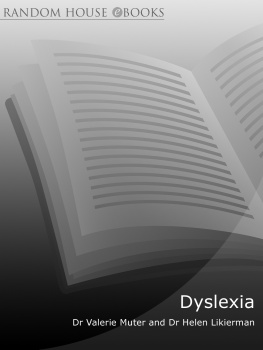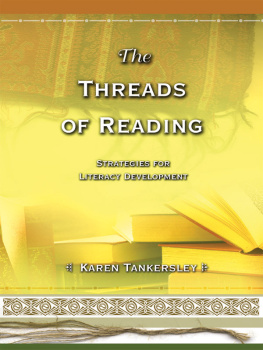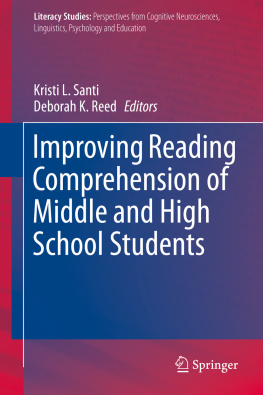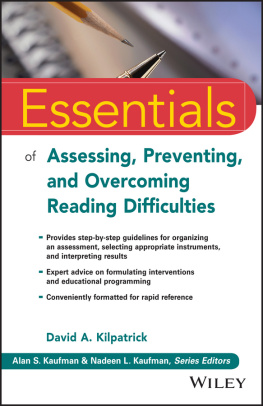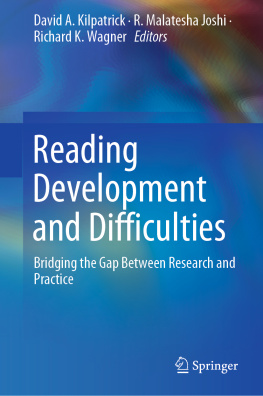Copyright 2013 Prufrock Press Inc.
Edited by Lacy Compton
Production design by Raquel Trevino
ISBN-13: 978-1-61821-017-3
No part of this book may be reproduced, translated, stored in a retrieval system, or transmitted, in any form or by any means, electronic, mechanical, photocopying, microfilming, recording, or otherwise, without written permission from the publisher.
At the time of this books publication, all facts and figures cited are the most current available. All telephone numbers, addresses, and website URLs are accurate and active. All publications, organizations, websites, and other resources exist as described in the book, and all have been verified. The author and Prufrock Press Inc. make no warranty or guarantee concerning the information and materials given out by organizations or content found at websites, and we are not responsible for any changes that occur after this books publication. If you find an error, please contact Prufrock Press Inc.
 | Prufrock Press Inc.
P.O. Box 8813
Waco, TX 76714-8813
Phone: (800) 998-2208
Fax: (800) 240-0333
http://www.prufrock.com |
Introduction
NO academic skill is more vital than the ability to read (Edmonds et al., 2009). Without reading skills, the chances for an individuals academic and occupational success are limited (Lyon, 1998b). As proof, we merely need to engage in a rudimentary investigation to discover that reading disabilities have a tremendous social impact.
A research study conducted by the Pew Research Center indicated that at the end of 2007, more than one in every 100 adults was confined in an American jail or prison (Pew Center on the States, 2008). According to figures gathered and analyzed by the Pew Public Safety Performance Project, in total, approximately 7,300,000 United States citizens were either in jail, in prison, on probation, or on parole. Translated, that is one out of every 31 American adults (Pew Center on the States, 2008). Additionally, the United States has 5% of the worlds population but 25% of the worlds prison inmates (Loury & Western, 2010). Why is this information significant in terms of reading? Because further research demonstrates that three-fourths of those incarcerated have not graduated from high school and a staggering 70% are functionally illiterate and read below a fourth-grade level (Barton, 2011). These figures are a clear indication that reading instruction in American educational institutions is problematic.
This is directly related to the nature and structure of American educational institutions where inadequate instruction in phonemic awareness and basic spelling rules leads to the development of inadequate code-breaking skills, which translates into the creation of a disability in basic reading skills.
A disability in basic reading skills is primarily caused by deficits in phonological awareness, which is independent of any achievement capacity (Lyon, 1998b). More clearly stated, reading disability has no connection with learning capacity or intelligence. Further, deficits in phonological awareness can be identified in late kindergarten and first grade using inexpensive, straightforward testing protocol, and these deficits can be remediated using a systematic approach to breaking the English code. This book takes that systematic approach and breaks it down for parents and teachers, while presenting some basic information on dyslexia and other reading difficulties and general strategies that can be used to improve students reading skills.
How to Use This Book
The primary objective of School Success for Kids With Dyslexia and Other Reading Difficulties is to provide parents and teachers with goals and a structured approach that will meet the needs of students requiring either primary instruction or remediation in the decoding and encoding of the English language.
This work provides a systematic and forensic approach to mastering the English language and a solid foundation for reading, writing, and spelling skills for students who are struggling with language acquisition. With this forensic approach, students can be shown the phonetic nature of the English language and the proper structure of the written language.
This book was written for use by dedicated parents and by teachers, educational specialists, language specialists, and mainstream or special needs English departments. If a departmental approach is used, it is recommended that the department nominate one individual, preferably one who is trained in the Orton-Gillingham approach, to evaluate the appropriateness of its application and to make determinations concerning its continued usage. This guide should be presented at the pace determined by the presenter, whose determination should be based solely upon the mastery level of the student.
The system herein has been organized to provide fluidity of information to ensure success. Concepts that build upon other concepts have been placed accordingly. Although some of the presentations may seem repetitious, this commonly utilized method enhances the students exposure to foreign concepts and fosters mastery.
I am aware that throughout this book, I have included information that crosses the line into the arena of speech pathology. I do this in order to familiarize those who have not had the exposure to speech pathology that I have received over my 27-year career. The information that I have gained over this period of time has served to strengthen my grasp of the articulation process and its inseparable relationship to phonemic awareness. In order to pass this information on to struggling students so that they may receive the full benefit of language remediation, parents and teachers themselves must become familiar with the process of articulation and its inseparable relationship to phonemic awareness. The phonemic details that permeate this book will serve as this resource.
You will find as you progress through this work that there are no cute little animals, funny faces, games, or anything else to distract the student from the task at hand. This curriculum is not designed to entertain. With this book, I merely seek to explicitly and systematically teach the intrinsic relationship between sounds and the symbols that represent them in the English code.
As we proceed with helping remediate the language and reading skills of our students, remember the words of the novelist Marcel Proust, who wrote:
The real voyage of discovery
consists not in seeking new landscapes...
... but in having new eyes.
Let us move forward and develop our new eyes.

chapter
The Development of Reading Skills
THE most fundamental responsibility of schools is to teach students how to read (Moats, 1999). The development of reading skills obviously serves as the gateway to the world of printed information, as reading serves as the major foundational skill for all school-based learning (Lyon, 1998a). Most, if not all, of the informal education that we receive is accomplished without the use of printed material. Historically, the oral tradition was the foundation of the informal education process and continues to remain so. However, school presents a different situationformal education in school requires the ability to read printed material. Through the development of reading skills, we prepare ourselves for our journey toward learning the material that must be mastered during the formal education process.






